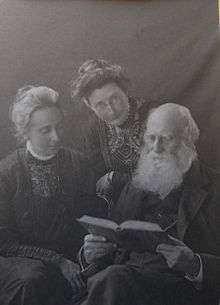Florence Stoney

Florence Ada Stoney (1870 – 7 October 1932) was an Irish radiologist and the first female radiologist in the United Kingdom.
Biography
Stoney was born in 1870 in Dublin to George Johnstone Stoney and Margaret Sophia Stoney. She attended the Royal College of Science and, since women in Ireland were unable to study medicine, moved to London to study at the London School of Medicine for Women. She obtained her MBBS with honours in 1895 and a Doctor of Medicine in 1898.[1]
In 1902, Stoney began lecturing in anatomy at the London School of Medicine for Women and working as a radiologist at the Royal Free Hospital; she was the first female radiologist to work in the United Kingdom.[1] She worked largely with X-rays, often developing the radiographic plates at her own house, but was not an official member of the hospital staff or the X-ray department committee. When World War I broke out in August 1914, Stoney and her sister Edith, a medical physicist, volunteered to assist the British Red Cross, but both were refused by surgeon Frederick Treves since they were women.[1] Despite the refusal, Stoney prepared an X-ray installation and helped to organise a unit of women volunteers with the Belgian Red Cross in Antwerp, where she managed the surgical unit in a makeshift hospital located in an abandoned music hall.[2] After enduring ongoing shellfire for 18 hours, the hospital was evacuated. Upon returning to England in 1915, she began full-time work at the 1000-bed Fulham Military Hospital;[1] she was one of the first five women doctors to be given full-time work with the War Office.[2]
After the war, Stoney was awarded a 1914 Star and an Order of the British Empire (OBE).[1] She practised as a radiology consultant at two hospitals Bournemouth: the Royal Victoria Hospital and the West Hants Hospital.[3] She published research on fibroids, goitre, Grave's disease, soldier's heart, rickets and osteomalacia, and particularly the use of X-ray in the treatment of these conditions.[2] Her health gradually deteriorated, in part due to overexposure to radiation. After retiring in 1928, she travelled to India to research the effects of osteomalacia-mediated pelvic deformities on childbirth. She died in 1932 following a "long and painful illness".[1] An obituary published in the British Medical Journal characterised Stoney as "quietly humorous, with a gift for steady perseverance that overcame the handicap of health which was never robust".[2] Another wrote, "she worked for the love of her profession and of her patients, and asked no honour and no thanks. She was a pioneer in radiology, and a great woman doctor."[3]
References
- 1 2 3 4 5 6 Thomas, Adrian. "Florence Stoney". British Institute of Radiology. Retrieved 12 June 2014.
- 1 2 3 4 "Florence A. Stoney, O.B.E., M.D. Bournemouth". British Medical Journal. 2 (3745): 734. 1932. doi:10.1136/bmj.2.3745.734.
- 1 2 Smith, S. Watson (1932). "The Late Dr. Florence Stoney". British Medical Journal. 2 (3746): 777. PMC 2521825
 . PMID 20777135. doi:10.1136/bmj.2.3746.777.
. PMID 20777135. doi:10.1136/bmj.2.3746.777.